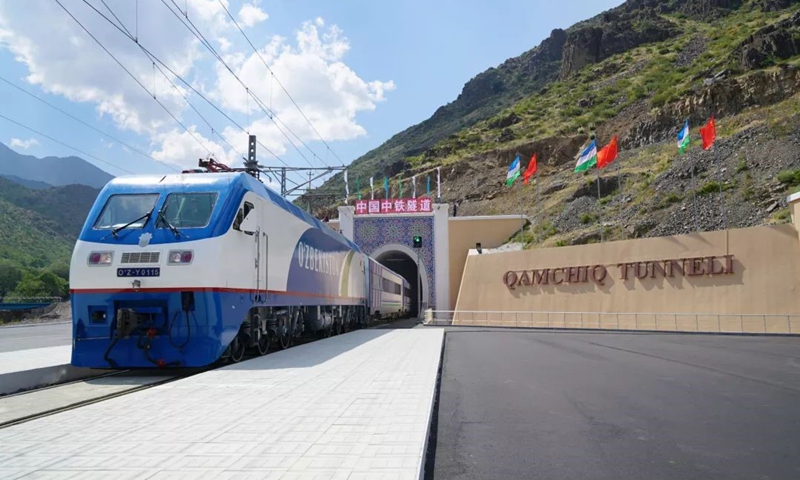Running through the mountains in Central Asia, the Angren-Pap railway line is a milestone project between China and Uzbekistan built under the Belt and Road Initiative. It is also part of an international transport corridor along the Silk Road that links up China, Central Asia and Europe. The railway line's main tunnel, the Qamchiq Tunnel, is the first railway tunnel in Uzbekistan. Extending 19.2 kilometers, it is the longest tunnel in Uzbekistan and Central Asia. A miracle in the history of tunnel building, it is known as "President Project No.1."

The Qamchiq Tunnel
The project was completed in less than three years and every step of the way is still vivid in people's memory: A field survey was conducted on May 24, 2013; the project division was set up on July 11; the EPC contract entered into force on July 29; and the first blasting was initiated on September 5; On March 26, 2015, the tunnel's entrance was successfully connected to the first shaft; and on February 25, 2016, all the digging work was completed. From the first digging to the holing-through of the tunnel, it only took workers 900 days to finish the project, allowing trains to travel through the mountains in just 900 seconds.
Behind such marvelous speed is the great resolve and courage of the Chinese and Uzbek workers in the face of unimaginable difficulties. The tunnel passes through seven different geologic faults. During the construction, rock bursts above medium intensity alone happened over 3,000 times. The most serious burst resulted in a 2,000-cubic-meter collapse, posing a grave threat to the personal safety of construction workers and causing serious psychological distress to them. Each year, they had to work in the winter season for five months, with temperatures dropping to - 43 degrees Celsius. Avalanches could easily happen anytime. However, the project went on, without a single day's delay. Against such harsh conditions, the workers rose to the challenge. They went on having cross-border meetings to carry out disaster risk assessments, make tailored plans and work for breakthroughs in scientific research. Using Chinese technologies and standards, they worked at a truly remarkable Chinese speed, blazing a trail out of impossible conditions.
The tunnel has become a new bond of friendship and cooperation between the peoples of China and Uzbekistan. Then Uzbek President Islam Karimov highly commended the project and the Chinese workers in his 2016 New Year address and at a January cabinet meeting on the economic situation. The project received not only great attention from Uzbek leaders, but also the support of the local people. During the construction, China Railway Tunnel Group hired many local workers, which helped drive local employment. Jiaheng, a local train driver, became fluent in Chinese after working on the project for two and a half years, and the income he earned on the project allowed him to support his parents and send his younger brother to college. The project has made him the family's bread-earner. "If more Chinese projects are hiring, I will definitely sign up," said Jiaheng to a reporter. In Uzbekistan, there are many more just like Jiaheng, making their contributions to the project and deepening China-Uzbekistan friendship as the tunnel extends.

On 22 June 2016, Chinese President Xi Jinping (left) and then President of Uzbekistan Islam Karimov jointly attend in Tashkent the opening of the Angren-Pap railway line via video link
The tunnel is a demonstration project of Belt and Road cooperation on connectivity. Before the tunnel was built, to travel from Tashkent to Fergana, local people had to go via another country and make a 150-kilometer detour. Now the journey only takes three hours, cutting short travel time by six hours. The project has been a great boost to Uzbekistan's railway and economic and social development. On June 22, 2016, Chinese President Xi Jinping and then President of Uzbekistan Islam Karimov jointly attended in Tashkent the opening of the Angren-Pap railway line via video link, and extended congratulations on the opening of the tunnel. This miraculous project, which was highly valued by the two countries and received worldwide attention, represents a new story between the Chinese and Uzbek people. It has strengthened the ties of friendship and brought the benefits of Belt and Road cooperation to the world.
Uzbekistan is a major country in Central Asia, a region that was once an important area along the ancient Silk Road. Because of the history and tradition, geographical proximity, cultural bonds and political and legal support, China and Central Asian countries are well-placed to contribute to the Belt and Road Initiative, and such cooperation has been widely endorsed and supported by the people. "A man of wisdom is resourceful and especially good at seizing opportunities." China will work with Uzbekistan and other countries to seize the historic opportunity, tackle various risks and challenges and pursue greater progress of the Belt and Road Initiative in both breadth and depth. Under the Belt and Road Initiative, the time-honored friendship between China and Central Asian countries will shine even brighter.





